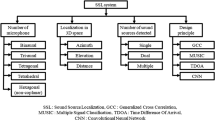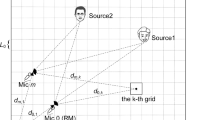Abstract
We describe the first single microphone sound localization system and its inspiration from theories of human monaural sound localization. Reflections and diffractions caused by the external ear (pinna) allow humans to estimate sound source elevations using only one ear. Our single microphone localization model relies on a specially shaped reflecting structure that serves the role of the pinna. Specially designed analog VLSI circuitry uses echo-time processing to localize the sound. A CMOS integrated circuit has been designed, fabricated, and successfully demonstrated on actual sounds.
Similar content being viewed by others
References
D. W. Batteau, “The role of the pinna in human localization.” Proceedings Royal Society London, Services B 168, pp. 158± 180, 1967.
N. A. Bhadkamkar, “Binaural source localizer chip using subthreshold analog CMOS.” In Proceedings of ICNN, pp. 1866±1870, 1994.
Journal Blauert, Spatial hearing: the psychophysics of human sound localization. MIT Press, 1983.
Earthworks, Inc., P.O. Box 517, Wilton, NH 03086. M30 Microphone.
Y. Hiranaka and H. Yamasaki, “Envelop representations of pinna impulse responses relating to three-dimensional localization of sound sources.” Journal Acoust. Soc. Am. 73, pp. 29, 1983.
E. Knudsen, G. Blasdel, and M. Konishi, “Mechanisms of sound localization in the barn owl (tyto alba).” Journal Comp. Physiol 133, pp. 13±21, 1979.
Journal Lazzaro and C. A. Mead, “A silicon model auditory localization.” Neural Computation 1, pp. 47±57, 1989.
Journal C. Licklider, “A duplex theory of pitch perception.” Experientia 7, pp. 128±133, 1951.
R. F. Lyon and C. A. Mead, “An analog electronic cochlea.” IEEE Transactions Acoust., Speech, Signal Processing 36, pp. 1119±1134, 1988.
C. A. Mead, Analog VLSI and Neural Systems. Addison-Wesley, 1989.
Journal Middlebrooks and D. Green, “Sound localization by human listeners.” Annual Revenue Psychol. 42, pp. 135±159, 1991.
L. S. Smith. “Sound segmentation using onsets and offsets.” Journal of New Music Research 23, 1994.
A. Watkins, “Psychoacoustical aspects of synthesized vertical locale cues.” Journal Acoust. Soc. Am. 63, pp. 1152±1165, 1978.
L. Watts, D. Kerns, R. F. Lyon, and C. A. Mead, “Improved implementation of the silicon cochlea.” IEEE Journal of Solid-State Circuits 27(5), pp. 692±700, 1992.
W. A. Yost and G. Gourevitch, Directional Hearing. Springer-Verlag, 1987.
Author information
Authors and Affiliations
Rights and permissions
About this article
Cite this article
Harris, J.G., Pu, CJ. & Principe, J.C. A Monaural Cue Sound Localizer. Analog Integrated Circuits and Signal Processing 23, 163–172 (2000). https://doi.org/10.1023/A:1008350127376
Issue Date:
DOI: https://doi.org/10.1023/A:1008350127376




